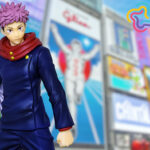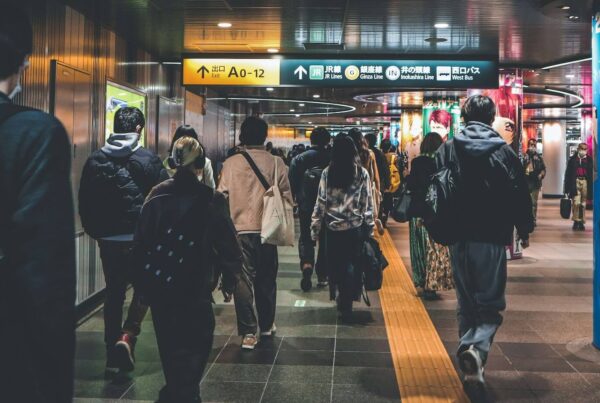Top Things to Do and Places to Visit in Gifu City – To international travelers, the name Gifu denotes rustic villages, snowy mountains, and hidden onsens.
However, Gifu is both the name of the prefecture as well as the local capital, with the city easily accessible from Nagoya using the JR Tokaido Line or the Meitetsu Nagoya Line. A historical city, and in recent years, a fashion center as well, Gifu City is full of traditional, natural, and modern attractions, making it perfect as a day-trip destination from Nagoya.
Should you be visiting Gifu City during your next Japan trip, the following are the top things to do and the best attractions to include in your itinerary. Including but a few would easily make for a fascinating day.
Table of Contents
Gifu Castle
Gifu Castle, a leading symbol of the city, regularly features on list of best Japanese castles to visit.
Though a cement reconstruction dating from the 1950s, the classic design of the keep is a joy for amateur and professional photographers alike. The observation deck of the keep, and the position of the castle on a mountain top, also offers magnificent, panoramic views of the entire city.

A mountain castle, you will feel on top of the world from the observation deck of the Gifu Castle.
Best of all, Gifu Castle is open till late between late April and August, making this mountain stronghold one of the easiest ways to visit a Japanese castle at night without coinciding with any festive event.
Lastly, the interior is home to a mini-museum featuring the history of the castle. Visitors fascinated with the Warring States Era of Japanese history will be thrilled to learn about the castle’s association with the legendary warlord, Nobunaga Oda.
Nobunaga Oda and Gifu City
The famous warlord was not from Gifu, then known as the Mino Province. However, he did marry the daughter of Saitō Dōsan, the ruler of the province. Nobunaga eventually also absorbed the province into his territory and gave it its modern name.
Thanks to this historical association, you will encounter Nobunaga throughout Gifu City. In fact, he is but mere steps away when you arrive by train. A golden statue of him stands right before JR Gifu Station.
Mount Kinka
Mount Kinka is the mountain on which Gifu Castle stands on, and is the equivalent of Victoria Peak and Mount Lycabettus for Gifu City. A massive green lung at the heart of the city, the top spots here are the castle, restaurants with spectacular views, and four hiking trails. For children and the young-at-heart, there’s also the Kinka Squirrel Village, where for a small fee you can get up close and personal with the energetic critters.
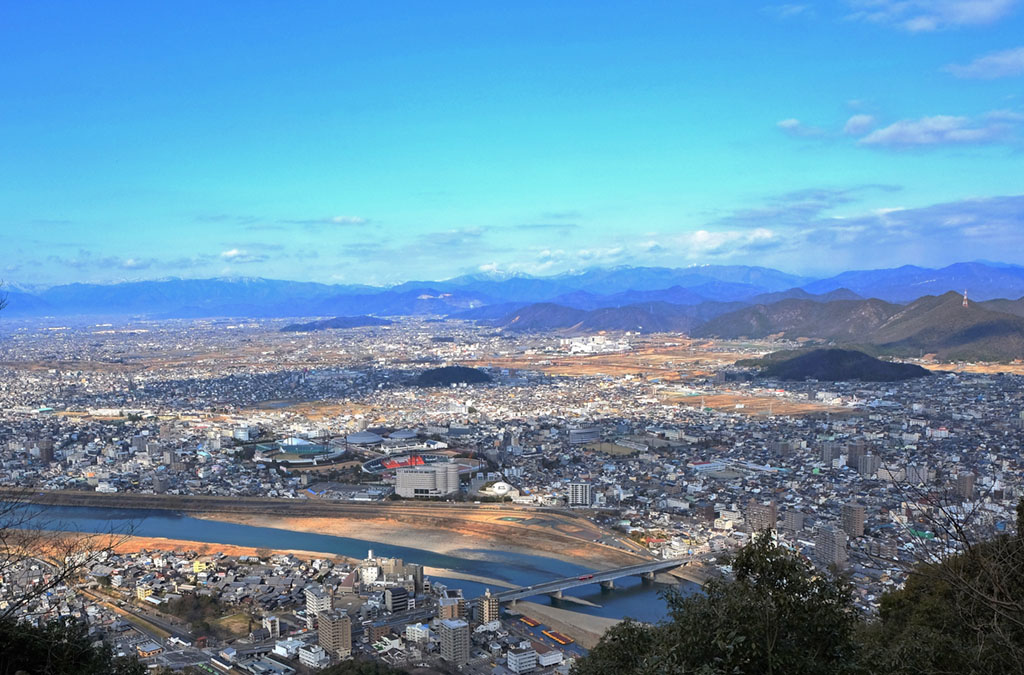
The view from Mount Kinka on a clear winter day. This stunning panorama that stretches forever is reason enough to ascend the mountain.
Should you not prefer to hike during your visit, worry not too, the summit of Mount Kinka is conveniently accessible by ropeway. The summit station of the ropeway is also right beside the restaurants and squirrel village. From there, it is but a short walk to splendid Gifu Castle.
Read also:
Shirakawa-go Travel Guide – Visit the Traditional Villages With Thatched Roofs
Gifu Park

Gifu Park has a picture-perfect vermillion pagoda, among other attractions. (Source: Wikipedia)
Gifu Park is in short, the green space surrounding the lower station of the Mount Kinka Ropeway. Least that sounds boring to you, the area is sizeable, beautifully landscaped, and full of traditional Japanese architecture. There’s also a lovely three-tiered pagoda, an art museum, teahouses, and even a small Buddhist shrine.
For history-buffs, the evacuated ruins of Nobunaga Oda’s former residence would no doubt be a key attraction. Mighty as the warlord was, even he found living in the mountain-top Gifu Castle way too inconvenient. Like other aristocrats of then, he preferred his residence closer to the ground.
Great Buddha of Gifu (Shōbō Temple)
Though less famous than its counterparts at Kamakura and Nara, the Great Buddha of Gifu at Shōbō Temple is still a spectacular sight to behold. As well as easy to visit as the temple housing it is but a short bus ride from Meitetsu-Gifu Station.
Completed in 1832 with distinctive Chinese elements, this 13.63m tall Buddha is actually taller than the Kamakura Big Buddha, in addition to being one of the largest dry-lacquered Buddha statues in Japan.
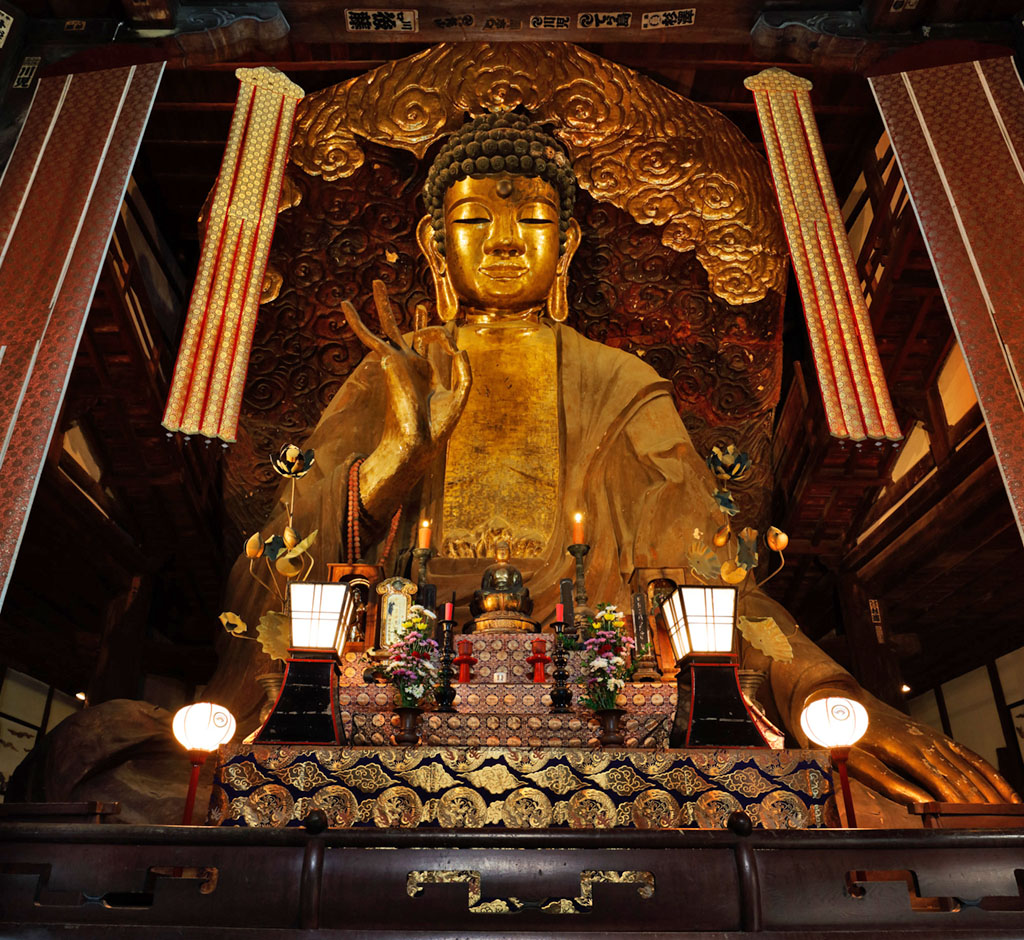
Standing before the majestic Great Buddha of Gifu City. One of the top things to do in the city after visiting the castle.
For visitors interested in Buddhism, Shōbō Temple is also home to a collection of arhat statues and Buddhist scenes. Together with the unglazed wooden main structure of the temple, standing before Gifu’s Great Buddha could be described as a wonderful spiritual experience. One that momentarily transcends time and space.
Read also:
Kin (Kogane) Shrine
Kogane Shrine is a straight-forward 15 minutes’ walk from Meitetsu-Gifu Station. You’d also know you’ve found it from afar. Apart from its striking vermilion-colored walls, the entrance is graced by a shiny golden torii gate. That’s right, a striking golden torii gate. Dedicated to Shinto Goddess Nunoshihime-no-mikoto, the shrine has long been considered the place in the city to pray for financial well-being; the very name of the shrine means gold in the Japanese language.
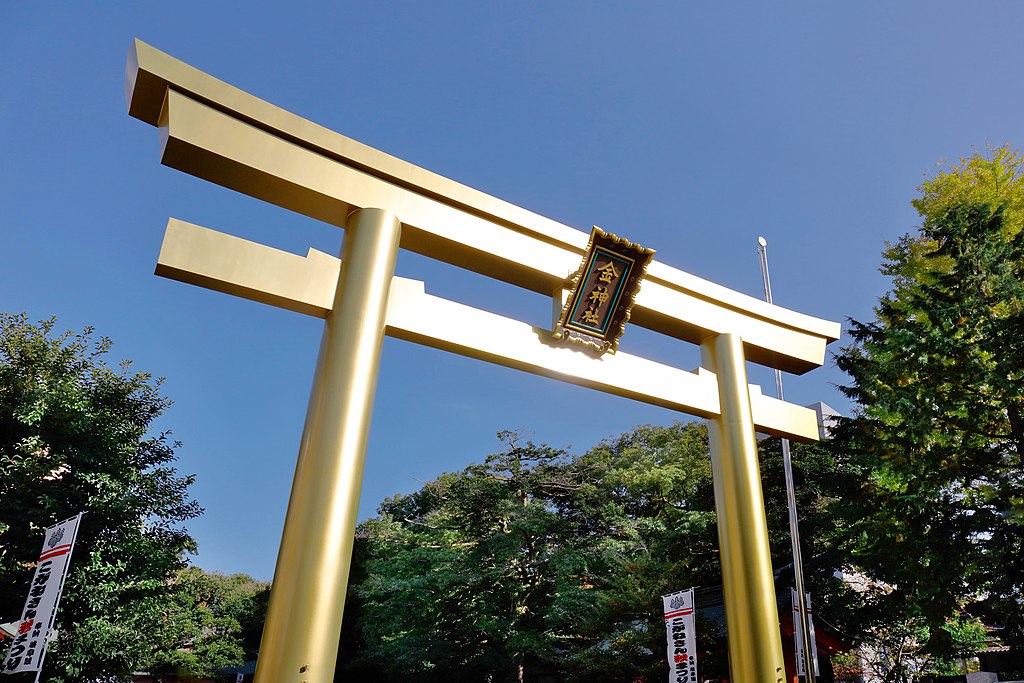
Looking for some financial blessings. Kogane Shrine is the top spot in Gifu City to head to! (Source: Wikipedia)
Kogane Shrine is additionally one of the top spots in Gifu City to welcome the New Year, with over a hundred thousand worshippers each year offering prays here over a three-day period. Lastly, the goddess is the wife of Inishiki-Irihiko-no-mikoto i.e. the patron god of Inaba Shrine (see below). Kogane Shrine is correspondingly one of the hosting shrines for the Gifu Festival. Visiting during the festival, or during the New Year, would be a crowded but extremely atmospheric experience.
Inaba Shrine
As mentioned above, Inaba Shrine is dedicated to Inishiki-Irihiko-no-mikoto, the husband of the goddess of Kogane Shrine.
Slightly away from the city center, this shrine is still worth your time for its rustic location and classic wooden structures. It is also located at the end of a lane flanked by stone lanterns, classic Japanese houses, and Buddhist Temples, making the journey to it quite the serene, if not spiritual experience.
- In stark contrast to Kogane Shrine, Inaba Shrine is all about harmonious wooden colors. (Source: Wikipedia)
- The Dragon Rock is Inaba Shrine’s friendly “mascot.” (Source: Google Maps)
Within the shrine, there is also a variety of classic structures and attractions to appreciate, including a short red torii tunnel and a “dragon-head” rock. The latter is a curious boulder that really resembles the face and jaw of a dragon. Should you toss it a coin, the ancient boulder might just grant you some magical blessings too.
Read also:
Nagaragawa Ukai Museum
Other than its castle, shrines, and association with Nobunaga Oda, Gifu City is famous for cormorant fishing on the Nagara River. In fact, the city is synonymous with this classic technique.
A collar is secured around the necks of the birds to prevent them from swallowing larger fish. Once returned to the boats, the birds spit out their prey. (Smaller fish are swallowed by them) Previously a thriving industry, cormorant fishing is nowadays mostly performed for visitors during the warmer months from May to October. Some of these demonstrations also include dinner.
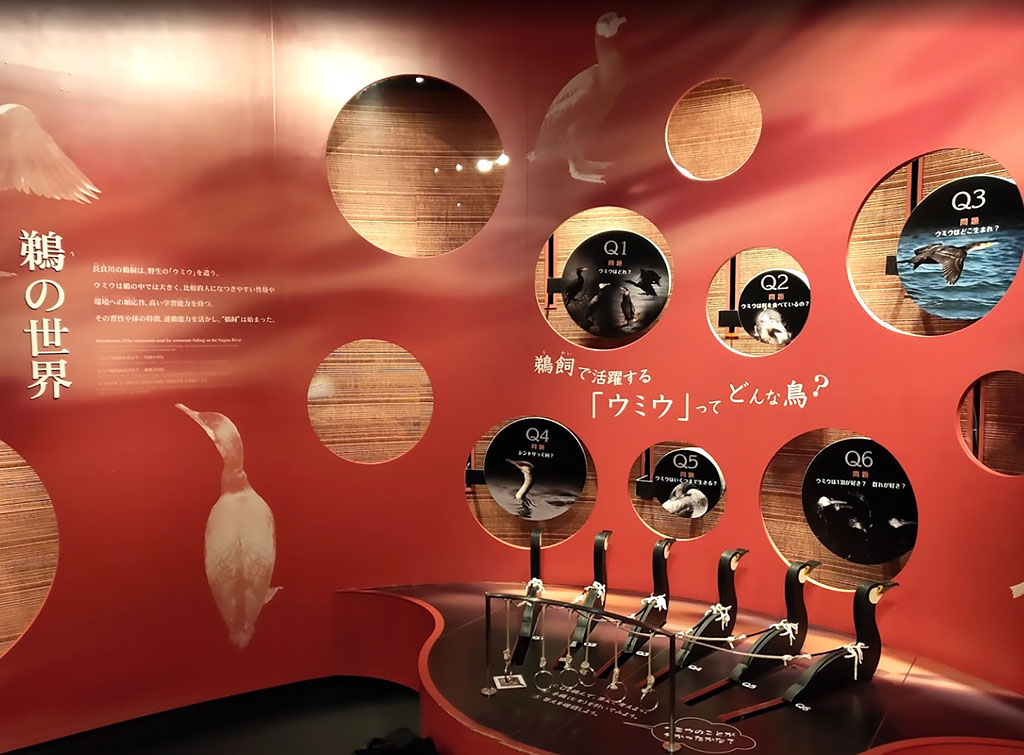
Learn all about the unique fishing method that’s synonymous with Gifu City. (Source: Google Maps)
And should you be visiting “out of season,” you can still learn about the history and heritage of the technique at the Nagaragawa Ukai Museum. Located across the Nagara River from Gifu Park, this modern museum in a classic wooden building lovingly details all there is to know about this unique fishing method. There are even actual cormorants here.
Furthermore, lush Mount Kinka is also in full-view from the museum. A light snack at the museum café could thus be a most relaxing way to end an afternoon.
Gifu City Tower 43 Observation Room
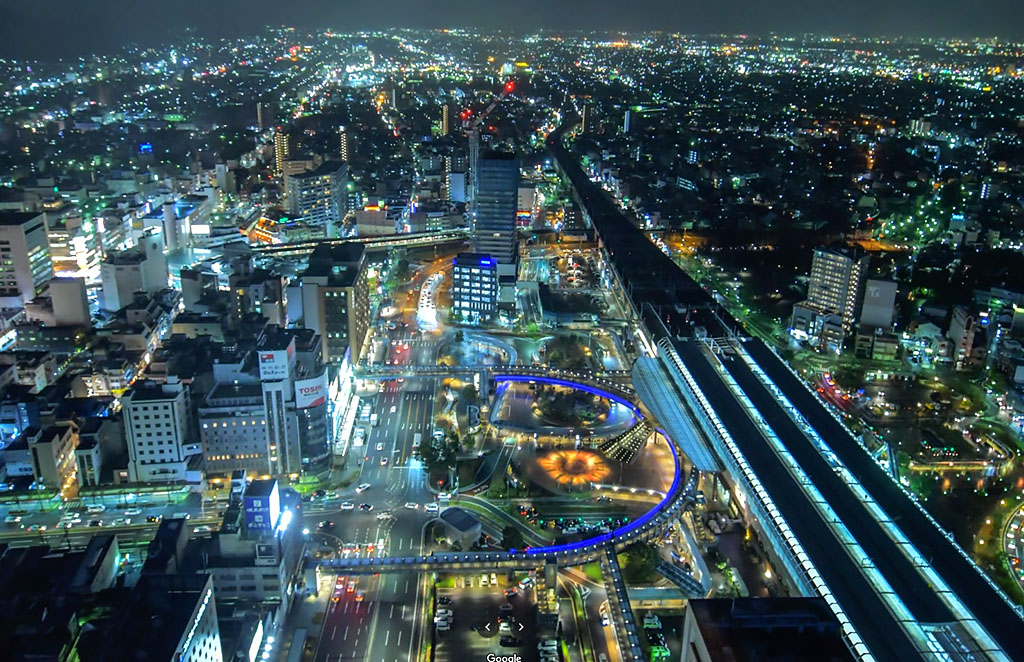
The stunning evening view from Gifu City Tower 43 Observation Room (Source: Google Maps)
Should you not be able to visit Gifu Castle or Mount Kinka at night, despair not. The twinkling lights of the city at night can still be easily enjoyed.
Located right next to JR Gifu Station, the observation room of Gifu City Tower 43 offers the same illuminated cityscape experience, and is opened up till 11pm every day (last entry at 10pm). It is also free for all, with a classy restaurant on the same level, making the attraction the perfect spot to end a full day with.
Additionally, the lower decks of the tower contains a variety of shops and restaurants, making it a convenient spot to pick up souvenirs and travel necessities before heading to your next destination. To repeat, there is no better place to conclude a day in Gifu City with. No other spot more beautiful and romantic too.
When is the best time to visit Gifu City?
If you don’t mind crowds, the annual Dosan and Gifu Festivals on the first Saturday of April and the following Sunday would hands-down be the most colorful time to enjoy the city.
Happening at different locations in the city, the festivals feature mikoshi shrine parades, marching band parades, as well as a variety of festive markets. In other words, all you’d expect from a lively Japanese matsuri.
Outside of the festivals, May and October would be the months for most travelers. Other than the pleasant weather, there is the chance to watch cormorant fishing.
Lastly, as a modern city, you’d be warm and well in winter. During peak travel seasons, the city could also be an alternative rest point when accommodations in nearby Nagoya are fully booked.
Be sure to follow us on Facebook, Instagram, Twitter, and Pinterest for more fun stuff! See you again next time!

Ced Yong
A devoted solo traveler from Singapore who has loved Japan since young. His first visits to the country were all because of video game and Manga homages. Today, he still visits for the same reasons, in addition to enjoying Japan’s culture, history, and hot springs.



